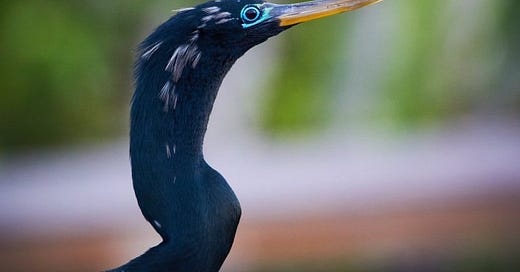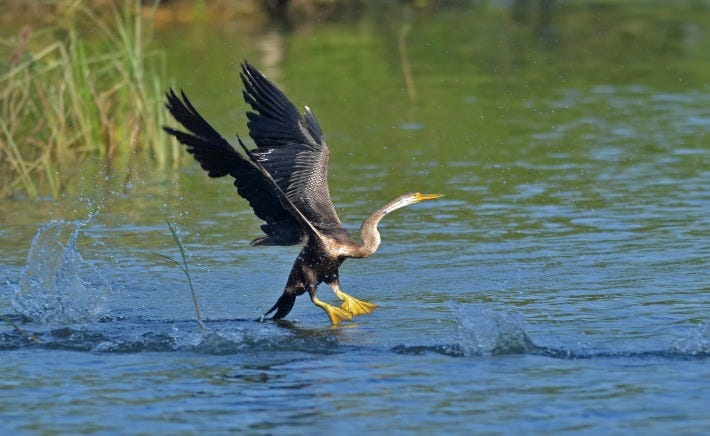I've been doing Bird of the Week for a while now, so I'm going to confess something: I like some birds more than others. Don't get me wrong, all birds are wonderful, but some birds bring a little extra to the table—either a look or a call or a general vibe that makes them stand out from the mass of perfectly respectable, but sometimes samey, feathered friends dotting the globe.
I don't know what it is about the water that seems to cause birds to get especially over-the-top, but it does. In previous installments, we have celebrated such weird and wild titans of the water as the great bittern and the Steller's sea-eagle. And now we have another bird to add to the list, one that has caused me to lose my mind a little bit because I dig it so much. Folks, meet the anhinga.
We're just getting started and already I'm going "AHHHHHHH." (This is a male anhinga, by the way; the female anhinga is kind of brownish-tan.)
Literally everything about this bird rules. Let's begin with the name. According to Cornell University's All About Birds database, "the name Anhinga comes from the Tupi Indians in Brazil, meaning 'devil bird' or 'evil spirit of the woods.'" I LOVE that. It's also known as a water turkey (lol), a darter, and, most resonantly, a snakebird. You can see why, looking at that neck.
"But wait," you're asking, "where's the rest of the bird??" Here you go.
Just holy wow. "What a beautiful goon," Caitlin said, and, as ever, she has managed to capture the situation quite neatly. The anhinga generally does its thing across a large swath of the southern U.S. (the National Park Service calls it "one of the most iconic, and most photographed, bird species that inhabit Everglades National Park," which makes me feel like a rube for never having heard of it till now) and throughout South America, reaching as far south as Argentina. I'm going to quote from this post on the Beauty of Birds site because it uses a word I like (guess what the word is!):
They favor warm shallow, slow-moving and sheltered waters and are found in open or partly open bodies of water with thick vegetation - such as bushes and tall trees - nearby for nesting, roosting and protection from predators.
They are commonly found in freshwater swamps, lakes, brackish lagoons, sluggish streams and mangroves. They frequent fresh or brackish water (= slightly salty water, such as found in estuaries).
(The word was "brackish." A bird that allows people to use the word "brackish" is a good bird.) This all makes me angry that I live in New York, where I have never seen an anhinga hanging out in any lake or stream. What the hell!
So what does the anhinga do in all of these lagoons, lakes, and swamps? Well, it devotes some time to family pursuits (anhingas are monogamous), but it also carries out its most highly prized activity: hanging out in the water and fishing. And here is where the anhinga ascends from great bird to god-tier bird. I am first going to quote (extensively) from the University of Michigan's Animal Diversity website (emphasis mine):
Anhingas start flight by either running on the surface of the water or diving from a tree. They usually return to the water by gliding into it from a perch or crawling into it from land. Only the head and neck are visible when in the water due to their low buoyancy. Most of the time spent in the water is devoted to fishing; otherwise they are found perched in trees. Often they crawl from the water and then up to a high perch in order to sun themselves. Similar to cormorants and turkey vultures, anhingas sun themselves by spreading out the wings, which dries out the plumage and absorbs heat from the sun. Anhingas lose heat quickly in the water due to their lack of an insulating layer of body feathers; thus, the sun's radiation helps them maintain body temperature.
[...] Anhingas prey primarily on fish, but their diet can also include aquatic invertebrates and insects. Although not particularly fast swimmers, they are effective aquatic hunters, relying on their quick necks and sharp bills to catch prey. They target slower-moving species of fish and stalk them underwater, finally striking out with their long neck and spearing the prey with the beak. They then bring the prey above water and manipulate it in order to swallow the fish head first.
I have no real comments other than to say that all of this is perfect. (Sorry to the fish though.) Now we will turn to some videos and you will, I assure you, join me in my awe.
Let's start small, with a nice little video of the anhinga flying.
OK, escalating now. Here's the anhinga sitting on a perch and sunning itself. Nothing happens in this video but everything happens in this video. ("That is somehow both a power move and the chillest thing I've ever seen," Caitlin said.)
Taking it up a notch....here's the anhinga calling. What a sound. Can this bird do anything wrong????
And now...the big guns. The fishing videos. It's time. Check this OUT.
To quote Caitlin yet again (she gets quoted a lot because, as she is Discourse Blog's other chief bird person, I am constantly spamming her with my Bird of the Week entries), "Nature is a madman!!!"
Let us just review what we've seen here: the snakey way the bird peeps above the water, then the dive under, then the marvelous form of the bird slinking its way through the water, then the catching of the fish and the deployment of the spearing technique and the swallowing of the fish in what feels like about 14 seconds! I mean.....this is a bird that knows what it's doing! There's another video where the woman filming says the anhinga caught at least 30 fish in 40 minutes:
(Side note: Judy, of "nature walks with Judy," is really good at her job! Concise, informative, with great visuals. 5 stars.)
OK I have gone on for over 1000 words, lol. So I have to end it. I am fully anhinga-pilled, this is one of the greatest birds of all time.
A reminder: you can check out our complete Bird of the Week list here, and get in touch with your bird suggestions at hello@discourseblog.com.







